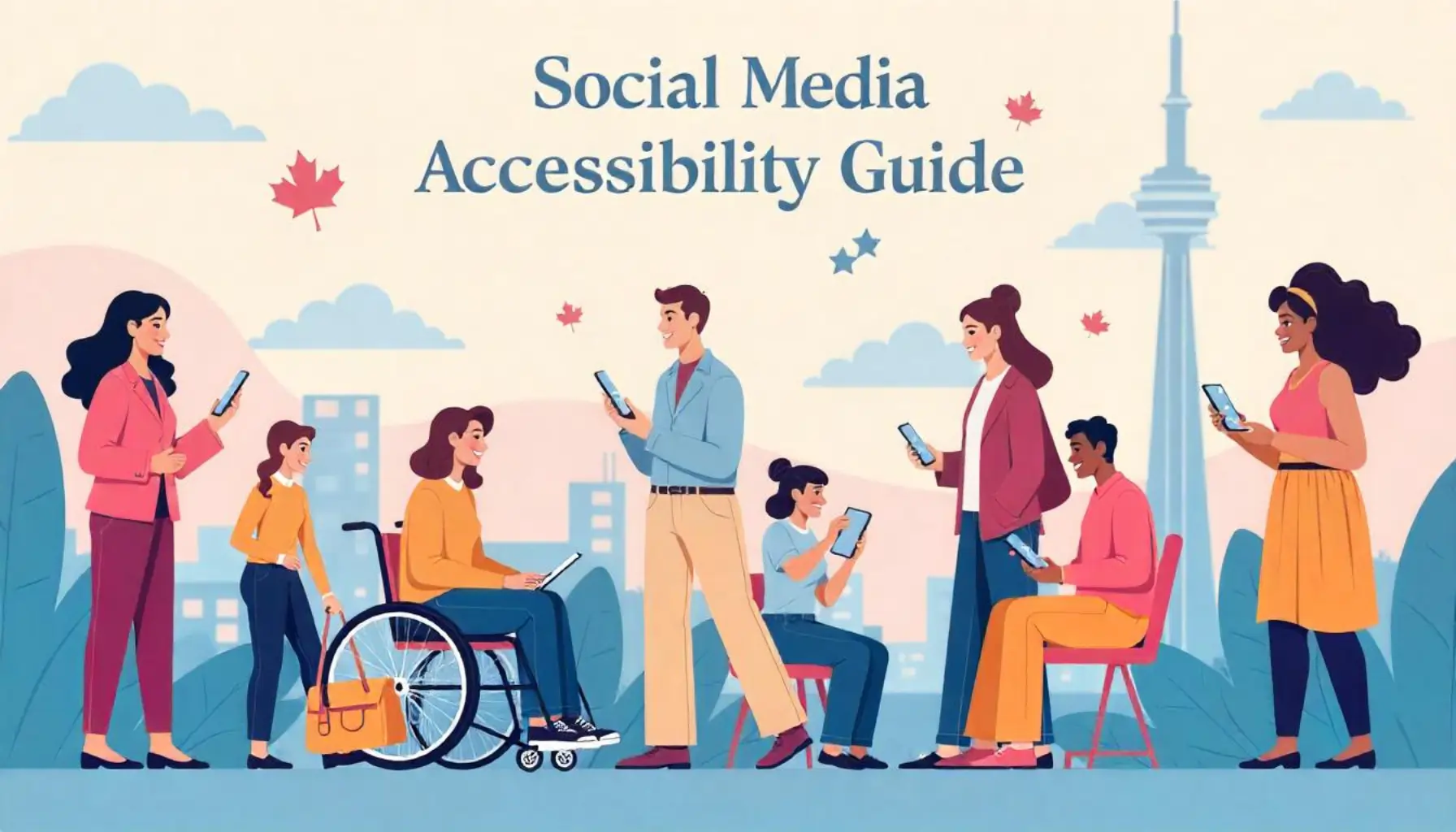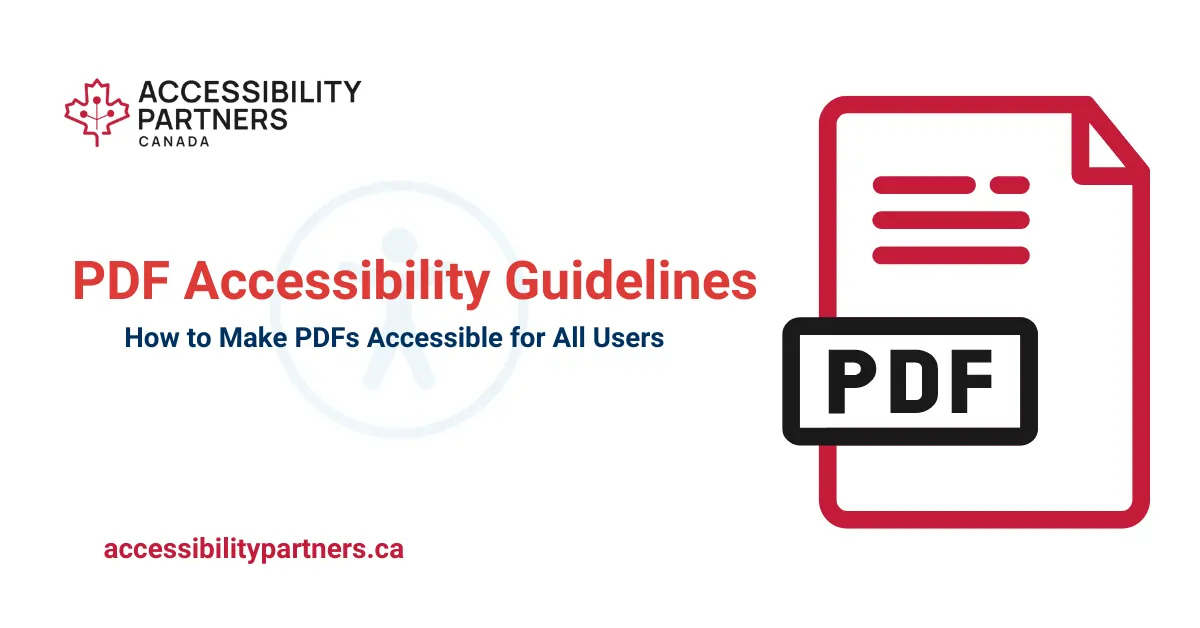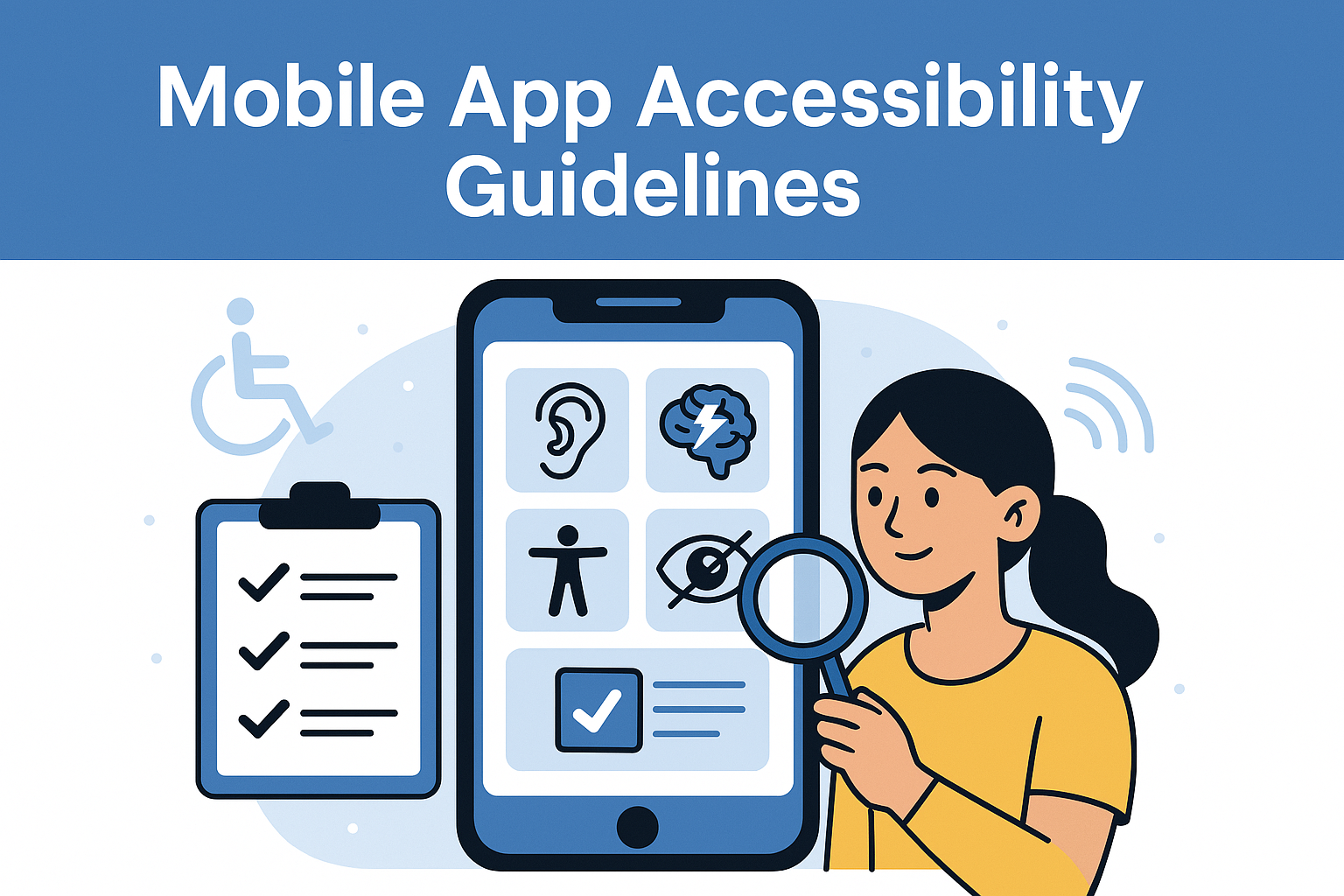In today’s digital landscape, social media accessibility is essential for ensuring that all users, including those with disabilities, can engage with online content. With regulations like the Accessible Canada Act (ACA) and AODA compliance for social media, businesses, municipalities, and organizations must adopt inclusive practices to avoid legal risks and enhance user experience.
Creating accessible social media content means going beyond basic compliance—it’s about fostering inclusivity and ensuring that every post, video, and image can be understood and interacted with by diverse audiences. Common barriers include missing alt text for social media, low-contrast visuals, inaccessible hashtags, and lack of captions or transcripts for videos. Addressing these issues improves engagement and ensures content reaches a broader audience.
This guide provides social media accessibility best practices, a checklist, and practical tips for making content more inclusive. Whether you’re a content creator, marketer, or government agency, these insights will help you meet the social media accessibility guide while creating a more inclusive digital space.
What Does Accessibility Mean in Social Media?
Social media accessibility ensures that all users, including those with disabilities, can fully engage with content across various platforms. This means removing barriers that may prevent individuals from reading, hearing, or interacting with posts, videos, and images.
When asking, “What does accessibility mean in social media?”, it refers to designing content that is inclusive for everyone. This includes adding alt text for images, providing captions for videos, using accessible hashtags with camel case (e.g., #SocialMediaAccessibility instead of #socialmediaaccessibility), and ensuring proper color contrast for readability.
Beyond legal compliance with laws like the Accessible Canada Act (ACA) and AODA standards for social media, accessibility fosters greater inclusivity and engagement. By making social media content more user-friendly for people with disabilities, businesses, municipalities, and organizations can broaden their reach and create a more inclusive digital community.
Why Social Media Accessibility Matters
In Canada, social media accessibility is more than just a best practice—it’s a legal and ethical responsibility for businesses, municipalities, and organizations. With legislation like the Accessible Canada Act (ACA) and AODA compliance requirements, ensuring that digital content is inclusive helps businesses avoid legal risks while fostering a more engaging and equitable online presence.
By prioritizing accessibility, businesses can reach a broader audience, including the 6.2 million Canadians living with disabilities. When content is not accessible—such as videos without captions, images without alt text, or poor color contrast—it excludes a significant portion of the population, limiting engagement and brand trust.
Moreover, accessible content enhances user experience (UX) for everyone, not just those with disabilities. Features like captions benefit users in sound-sensitive environments, and clear, structured content improves readability for all audiences. Businesses that invest in social media accessibility best practices not only align with legal standards but also demonstrate inclusivity, which can lead to stronger customer loyalty and a more positive brand reputation.
Social Media Accessibility Checklist For Making Social Content Inclusive
Ensuring accessibility in social media is essential for creating an inclusive digital space where everyone can engage with content. Businesses, organizations, and municipalities must follow the social media accessibility guide to comply with the Accessible Canada Act (ACA) and improve user experience. By adopting these social media accessibility best practices, brands can enhance engagement while avoiding accessibility barriers. Below is a checklist to help make your social content more inclusive.
Add Alt Text to Images
Providing alt text for social media ensures that visually impaired users can understand images through screen readers. Describe the image clearly and concisely, conveying its key message.
Make Your Text Accessible
Use high color contrast to improve readability, avoid all caps, and break up large blocks of text for easier comprehension. Additionally, structure hashtags in CamelCase (e.g., #AccessibleCanadaAct) to help screen readers interpret them correctly.
Be Mindful of Emojis
Excessive emoji use can disrupt screen readers, as each emoji is read aloud individually. Place them at the end of sentences instead of within the text to maintain content clarity.
Provide Captions and Transcripts for Videos
Captions ensure that individuals who are deaf or hard of hearing can understand video content. Transcripts offer an alternative way to access information, making videos more accessible across different platforms.
Use Accessible Fonts and Formatting
Avoid decorative or script fonts that may be difficult to read. Stick to clear, sans-serif fonts and ensure proper spacing between lines and letters to improve readability.
Ensure Clickable Links Are Descriptive
Instead of using vague phrases like “Click here,” write descriptive links (e.g., “Download the social media accessibility checklist”) so users know what to expect before clicking.
Test Content with Accessibility Tools
Use tools like screen readers, colour contrast checkers, and caption generators to test the accessibility of your social media posts before publishing.
How Can Accessibility Partners Help with Social Media Accessibility?
Creating accessible social media content requires expertise, compliance knowledge, and the right tools to ensure inclusivity. At Accessibility Partners, we specialize in helping businesses, municipalities, and organizations meet social media accessibility guide while enhancing engagement and compliance with laws like the Accessible Canada Act (ACA) and AODA requirements.
Here’s why you should choose Accessibility Partners over other competitors:
1. Proven Expertise in Social Media Accessibility Compliance
With years of experience auditing and improving digital accessibility, our team understands the WCAG 2.2 standards and how they apply to social media platforms. We go beyond generic recommendations, offering tailored solutions to address accessibility gaps specific to your content.
2. Data-Driven Accessibility Audits and Action Plans
Unlike other providers, we conduct in-depth accessibility audits—including real-world testing with assistive technologies—to pinpoint barriers in your social media channels. We don’t just identify issues; we provide a clear action plan to make your content fully inclusive.
3. Customized Training for Your Team
We offer social media accessibility training for content creators, marketing teams, and municipal communication departments. Our hands-on workshops ensure your team understands best practices for alt text, captions, accessible hashtags, and more.
4. Compliance Support to Avoid Legal Risks
Failing to meet accessibility standards can lead to compliance violations and reputational damage. We help organizations align with ACA, AODA, and WCAG 2.2 requirements, reducing legal risks while promoting inclusivity.
5. Accessibility Tools and Resources
We provide exclusive checklists, accessibility toolkits, and ongoing support to ensure your team consistently creates accessible social media content. Our resources make it easy to implement best practices across all platforms.
Get Expert Help with Social Media Accessibility from Accessibility Partners
Don’t let accessibility barriers limit your social media reach. Partner with Accessibility Partners to ensure your content is inclusive, compliant, and engaging for all users. Contact us today for a consultation, accessibility audit, or customized training session.
Tips for Creating Accessible Social Media Content
Crafting social media content that is accessible is more than just a best practice — it is a necessary approach for ensuring inclusivity. The task may seem hard at first, but breaking it down into manageable tasks can help Canadians to start to make their content open to more people. Social media accessibility best practices involve several key actions:
Here are some practical tips to get started on the path to making social media content more accessible.
Alternative Text for Images
When posting images, always include descriptive alternative text (alt text). This ensures that individuals using screen readers are able to understand what the image is about and can fully engage with your content.
Captioning for Videos
Non-textual content like videos should be captioned to provide an equivalent experience for those who are deaf or hard of hearing. Proper captions also benefit those who cannot play audio, increasing the potential audience of your video content.
Descriptive Links
Avoid using generic hyperlinks like “click here” or “read more.” Instead, provide descriptive links that give context and can be understood out of their original context, which is particularly helpful for those navigating through a screen reader.
Text Formatting
Simple and consistent text formatting makes content easier to read for everyone. Use headers to break up content, keep line lengths reasonable, and avoid excessive use of capitalization or italics that can hinder readability for some users.
Tools and Resources for Social Media Accessibility
Ensuring social media accessibility requires the right tools and resources to identify and fix accessibility barriers. From alt text generators to color contrast checkers, these tools help businesses, content creators, and organizations comply with social media accessibility guide while improving user experience.
Alt Text Generators and Checkers
- Microsoft Accessibility Checker – Ensures images have proper alt text and flags missing descriptions.
- ALT Text Tester – A browser extension that verifies if alt text is correctly implemented on social media images.
Colour Contrast Checkers
- WebAIM Contrast Checker – Evaluates text-background contrast for readability and WCAG compliance.
- Color Oracle – A free tool that simulates colour blindness to ensure inclusive design.
Captioning and Transcript Tools
- YouTube Auto-Captions (with Manual Edits) – Automatically generates captions, allowing for manual corrections.
Screen Reader Testing
- NVDA (NonVisual Desktop Access) – A free screen reader to test how visually impaired users navigate your content.
- VoiceOver (iOS & macOS) – Apple’s built-in screen reader for testing mobile accessibility.
Accessible Hashtag and Text Formatting Tools
- Hashtag CamelCase Converter – Ensures proper capitalization (e.g., #SocialMediaAccessibility instead of #socialmediaaccessibility).
- Hemingway Editor – Simplifies text to improve readability for users with cognitive disabilities.
By integrating these social media accessibility tools, businesses can create more inclusive content and improve compliance with AODA and Accessible Canada Act (ACA) standards.
Conclusion: The Journey to Make Social Media Inclusive
The ultimate goal of this social media accessibility guide is to reinforce the importance of inclusivity in digital spaces and provide actionable steps to achieve it. By adopting these recommendations, Canadians can ensure that their social media presence is welcoming to all, thereby contributing to a more connected and accessible online community.
Remember, accessibility is an ongoing commitment. Regularly revisit and update your social media practices to incorporate the latest best practices and feedback from your audience. By doing so, you’re not only meeting legal requirements but also maximizing the reach and impact of your content for all Canadians.
FAQs
Does the Accessible Canada Act apply to private businesses on social media?
Yes, the Accessible Canada Act (ACA) primarily applies to federally regulated entities, such as banks, telecommunications, and transportation sectors. However, private businesses are encouraged to follow social media accessibility best practices to improve inclusivity and avoid potential legal risks under provincial laws like the AODA in Ontario or the Accessible British Columbia Act.
What are some common social media accessibility mistakes to avoid?
Some of the most frequent mistakes include:
- Failing to add alt-text to images.
- Using poor colour contrast, making text difficult to read.
- Posting videos without closed captions or transcripts.
- Writing hashtags in all lowercase, which screen readers struggle to interpret.
- Overusing emojis, which can disrupt screen readers.
Are there any legal requirements for social media accessibility in Canada?
Yes, accessibility laws such as the AODA (Accessibility for Ontarians with Disabilities Act) require organizations to meet WCAG 2.2 guidelines for online content, including social media. While specific regulations vary by province, ensuring social media accessibility aligns with broader compliance requirements under Canadian accessibility laws.
What are the benefits of social media accessibility for Canadian businesses?
- Expands your audience to 6.2 million Canadians with disabilities.
- Improves user engagement and brand loyalty.
- Enhances SEO performance, as search engines prioritize accessible content.
- Reduces legal risks associated with non-compliance.
- Demonstrates a commitment to inclusivity and corporate social responsibility.
Do I need specialized training for social media accessibility?
While not mandatory, social media accessibility training is highly recommended. Accessibility guidelines are complex, and proper training ensures that your team can implement best practices like writing effective alt text, structuring accessible hashtags, and optimizing multimedia content.
How can social media accessibility improve my brand’s reach?
Accessible content ensures that more users—including those using screen readers, captions, or high-contrast settings—can engage with your posts. This improves engagement metrics, increases content shares, and strengthens brand reputation, making your content more visible to a wider audience.
How can I make my social media posts more accessible?
To improve social media accessibility, you should:
- Add alt text to all images.
- Provide captions and transcripts for video content.
- Use high-contrast colours for readability.
- Format hashtags in CamelCase (e.g., #AccessibleCanada instead of #accessiblecanada).
- Limit emoji use and place them at the end of sentences.
What free tools can I use to test social media accessibility?
- WebAIM Contrast Checker (for colour contrast testing).
- Microsoft Accessibility Checker (for alt text verification).
- NVDA Screen Reader (to test screen reader compatibility).
- YouTube Auto-Captions (for video captioning).
- CamelCase Converter (for accessible hashtags).







